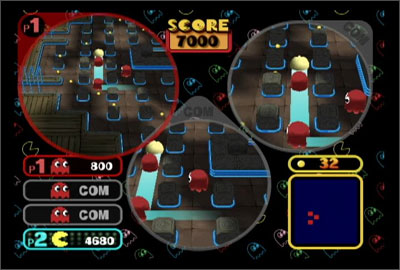Nintendo’s been going on and on for about a year now about the “asymmetrical gameplay” experiences that the Wii U will foster. It does look neat, and I think the little demos that they’ve provided seem like they’ll be fun for a while, but I wonder if there are any long-term applications for this style? Having an extra player play a support role in games like New Super Mario Bros U and Rayman Legends is a decent way to start, but I hope that somebody can do something really compelling with this bold new idea.
Oh, did I say “new”? I meant “thing that Nintendo has been doing intermittently and nobody cares about.”
Asymmetrical gameplay isn’t a new concept. It’s not even just a Nintendo thing. All it really means is that the two (or more) people are playing the same game and doing a different thing. Mario Party alone has been doing it for over a decade with the 3-vs-1 mini-games. Hell, Gyromite on the NES can be (and works considerably better as) an asymmetrical multiplayer game if you ditch ROB and have a friend use his controller instead. And that’s all the way from the 80’s.
I suppose those ones kind of make a point for the style though. Referencing the “nobody cares about” part of my statement earlier, let’s take a look at Super Mario Galaxy‘s multiplayer mode. Well, multiplayer in the sense that two people have controllers in their hands, anyway. All the second person does is wave around the pointer to collect star bits and stun enemies. Sure, you can point novice players in the right direction, but there’s a hole on my face that could accomplish the same thing more efficiently. New Super Mario Bros U’s “Boost Mode” is pretty much the same thing, and I can’t imagine it’s going to be much more compelling.
Why this is one of the big selling points of the Wii U, I don’t know. I suppose it’s because of the GamePad and the ability to give opposing players different views of what’s going on. That is what makes it truly asymmetrical, after all. But even that”s not new. Do you remember connectivity? That Nintendo buzzword from 2003 that never took off?
I may be misremembering, but the first example of GameCube-GameBoy Advance connectivity was Pac-Man Vs. This was a great idea. One player is Pac-Man, and he sees the entire maze on his GBA. The other players are the ghosts, and can only see a small area around themselves on the TV screen. So what you have is a multiplayer Pac-Man, but in a way that the ghost team doesn’t have such an overwhelming advantage. It’s brilliant, but was unfortunately much too hard to actually find, because it was given away as a limited free sample. It was also included in the GC versions of a handful of Namco games, but they weren’t of much interest to me and Pac-Man Vs, despite its brilliance, was not worth the price of a full retail game.

On the other hand, you have The Legend of Zelda: The Wind Waker. It featured a really cool multiplayer mode that most people probably didn’t even know existed. When you encounter Tingle in the game, he gives you a device called the Tingle Tuner, which you can use to summon him through a GBA. Here, a second player (using said GBA) is given a radar and several actions that they can use to help or hinder Link. The problem is that once the Tingle player gets bored of dropping bombs on Link, the whole experience is pretty shallow. Maybe some people like watching a radar and occasionally telling Link where a secret is hidden, but I sure couldn’t get my brother to commit to the role. I usually just had my GBA connected and sitting next to me so I could find the hidden items that are only visible through the GBA.
This mode can also become infuriating for the Link player, because every one of Tingle’s actions costs rupees, and those rupees come straight out of Link’s wallet. It’s especially bad in The Wind Waker, because it’s easily the most commerce-driven Zelda game. Also, the bomb thing.
If you really want to stretch, you could probably consider the first Final Fantasy: Crystal Chronicles to have asymmetrical gameplay. Not because each player had a different radar on their GBA screen or anything, but because the game sucked for whoever had to be the Bucket Bitch and was fun for everyone else.
I’ve never used them, but a couple of the Wii Guitar Hero games have a mode called “Roadie Battle” where two guitarists compete. Each of those guitarists is paired with another player who has a DS that allows them to send power-ups to their teammate or try to sabotage the opposing guitarist. It’s a spin on the “support player” idea that Wind Waker and Mario Galaxy use, but they do it right by keeping that support player engaged at all times, whereas the other games end up leaving the support player with nothing to do quite often. Maybe the game itself isn’t as compelling as a Mario or Zelda title, but at least you’re not bored.
So yeah. I’ve got just a few examples here (and most of them are a stretch at best), but I think I’ve made a decent case that asymmetrical game experiences probably won’t hold up as a Wii U back-of-the-box bullet point. Developers are really going to have to step up if they want to make asymmetrical experiences that will matter. Nintendo Land has at least two variants on Pac-Man Vs, but you’re going to need something with a little more depth than that if you want people to care.
